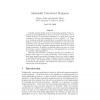Free Online Productivity Tools
i2Speak
i2Symbol
i2OCR
iTex2Img
iWeb2Print
iWeb2Shot
i2Type
iPdf2Split
iPdf2Merge
i2Bopomofo
i2Arabic
i2Style
i2Image
i2PDF
iLatex2Rtf
Sci2ools
FAC
2000
2000
Maximally Concurrent Programs
Typically, program design involves constructing a program P that implements a given specification S; that is, the set P of executions of P is a subset of the set S of executions satisfying S. In many cases, we seek a program P that not only implements S, but for which P = S. Then, every execution satisfying the specification is a possible execution of the program; we then call P maximal for the specification S. We argue that maximality is an important criterion in the context of designing concurrent programs because it disallows implementations that do not exhibit enough concurrency. In addition, a maximal solution can serve as a basis for deriving a variety of implementations, each appropriate for execution on a specific computing platform. This paper also describes a method for proving the maximality of a program with respect to a given specification. Even though we prove facts about possible executions of programs, there is no need to appeal to branching time logics; we employ a fr...
| Added | 18 Dec 2010 |
| Updated | 18 Dec 2010 |
| Type | Journal |
| Year | 2000 |
| Where | FAC |
| Authors | Rajeev Joshi, Jayadev Misra |
Comments (0)

